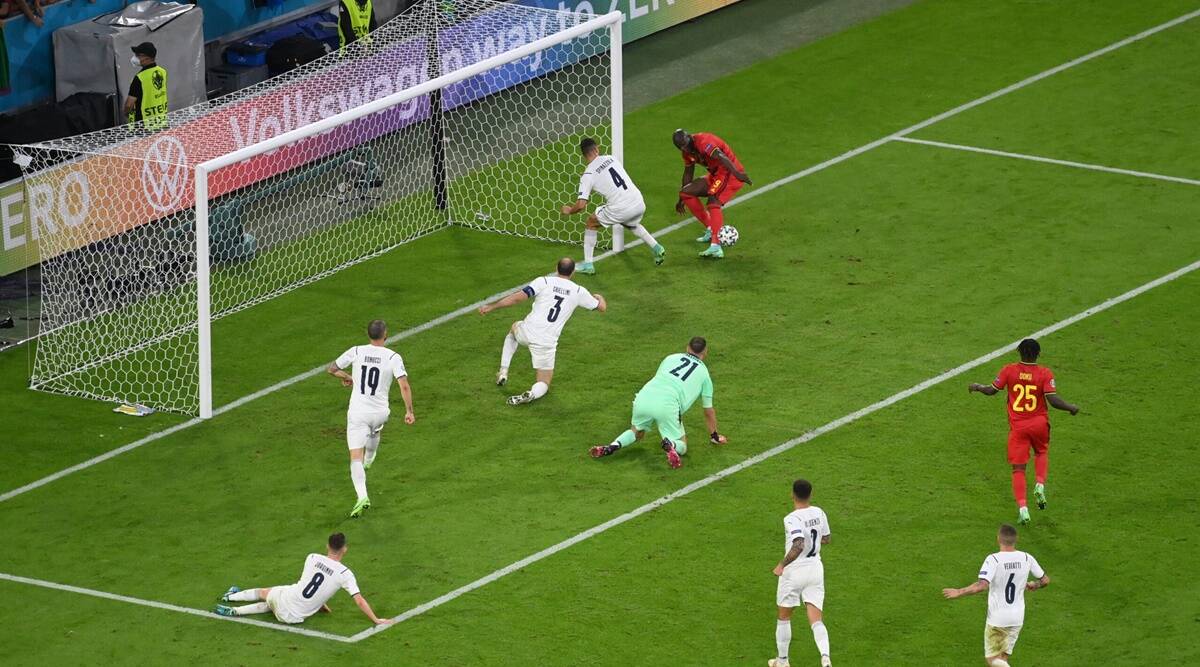When Romelu Lukaku lay bleak on the sideline and couldn’t understand how his shot was interrupted at the last second from two meters away, Italians Giorgio Chiellini and Leonardo Spinazzola celebrated feverishly at the side post.
Soon Leonardo Bonucci and Giovanni de Lorenzo joined the hand-to-hand combat. Their joy was limitless. As if one of them had scored a goal. A goal-refusing block as worthy of a goal. Or maybe more than one goal in context.
As Belgium accelerated in the hunt for equalizer, Jeremy Doku burned down the left side, burst into the field and slid a delicious ball at Kevin de Bruyne. He pushed the ball in the direction of Lukaku, who was only released from the shackles of Chiellini in the rarest of cases, and only had to turn the ball into the net. He did just that by not blasting the ball but just jumping out of nowhere for Spinazzola (he was pulled out due to injury in the 78th minute) and tucking his thigh between the ball and Lukaku.
The whole sequence – Spinazzola sniffed the danger and extinguished the shot without resorting to a wild tackle or cynical lunges – was a tribute to the fine art of defense that is still dear to Italian football. It wasn’t a last-ditch attempt at the rear, but a masterclass in defense.
This Italian team may be lively and velvety, but they have neither forgotten nor forbidden the soul of their football. Your defense is still its essence. Defense as artistic science or scientific art, defenders as surgeons and painters, scientists and sculptors. Those who tear the ball off their feet without disturbing the laces or splitting the shin guards. There were ugly settlement traders in Italy in the past who were rude and terrifying at times, but most of them from the 90s to the present day have been smooth operators. Rely on intelligence, anticipation and positioning instead of smoldering physicality. All of the negative stereotypes of the Italian defense arts – niggling and pinching and clever tugging of shirts – are unnecessary to Paolo Maldini and his descent from defensive artists and artisans.
Some of them might look belligerent. Like Chiellini, who resembles a thug in a pub who has broken his nose five times and had his ears chewed, but rarely bows to violence. He screams and screams forever, is happy and gesticulates. Strikers loathe these types of defenders because they are always there, even when physically absent, like a shadow. They are clogging your space and killing your morale, they are never in a hurry or rush, never clumsy or careless.
For Chiellini, son of an orthopedic surgeon, it’s more of a science. “Reading a striker’s mind is a subtle psychological game,” he said in his autobiography I, Giorgio. But it is not something that someone has born, but acquired over the years. Chiellini does this by watching footage of his opponents weeks before the game and understanding everything from idiosyncrasies to movements and preferences.
“It helps me connect with them. I need to know what they like most, what runs they do. It’s my way of getting on their wavelength and syncing with them. I also watch every goal a team has scored this season. You will get an understanding of how to play, how to score and how to guess your intentions. “
He seemed to have studied Lukaku so closely that he was a completely neutered force. This was another tribute to the great Italian defensive tradition – man-marking and the ability to win one-on-one challenges, which has gone out of style in this era of zone marking.
Each defender has his own role. Chiellini is the attacker. As one of the most natural central defenders with ball games, he storms opponents high up. Bonucci is something like a defensive regista, a self-proclaimed “soldier” who starts attacks and closes the time and space that the opponents get on the ball, always in the right place at the right moment and earlier, without allowing the attacker to do something to do what he wants.
In his duels with Kevin de Bruyne, the latter often came out second best, while Italy began several advances with him.
But it’s a more subtle craft than Chiellini, and so you might miss it if you don’t look out for it specifically. Spinazzola is the nerve of attack (although he is exceptionally trained in the fine virtues of Italian defense). Di Lorenzo combines the two and becomes the third central defender when Italy attacks. Even his moment of flaw that led to the penalty kick was a human exception.
Together they are an impregnable force and retain their relevance even if Italian football has lost its overemphasis on defense. But Italy’s ambitions are fueled by both the enterprising spirit of its strikers and the rigidity of its defense. That defensive scrum while Lukaku lay bleakly off the sidelines tells the story.

